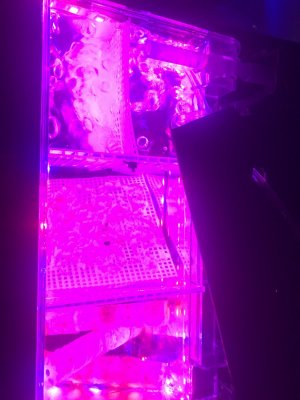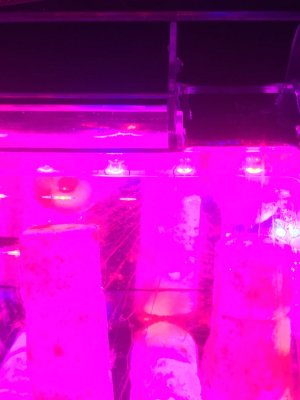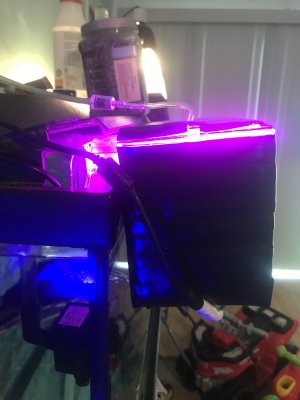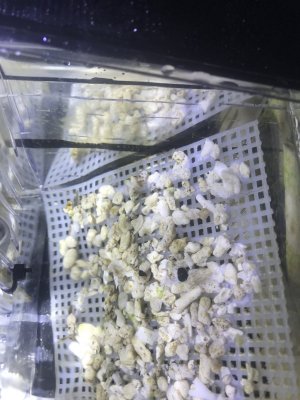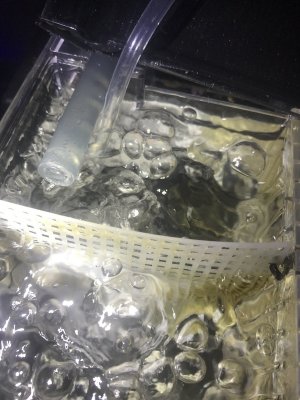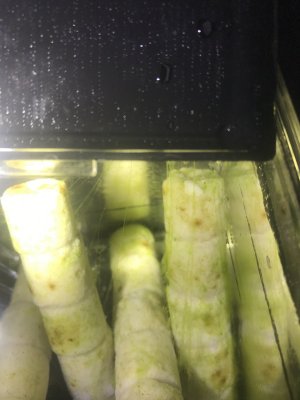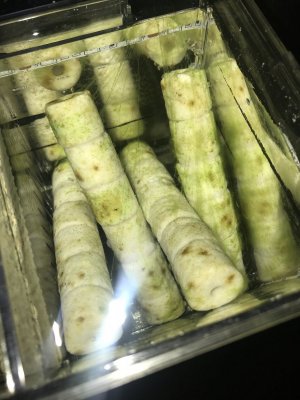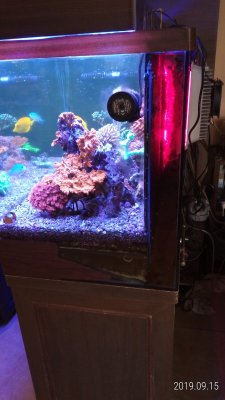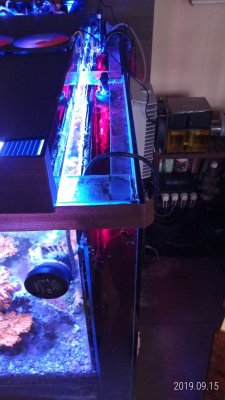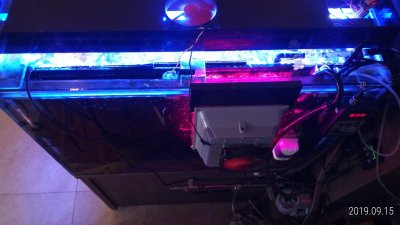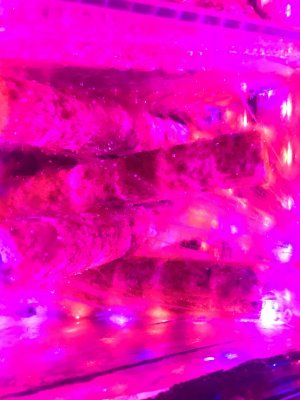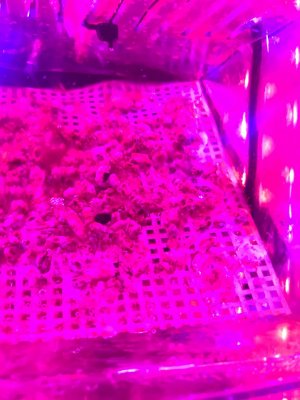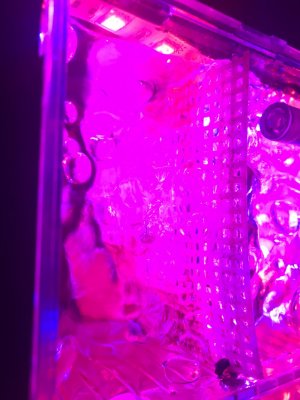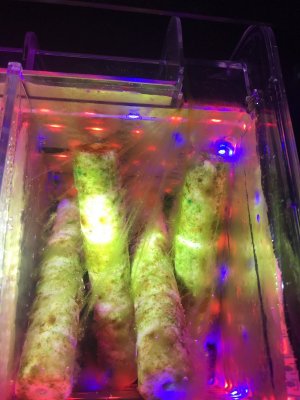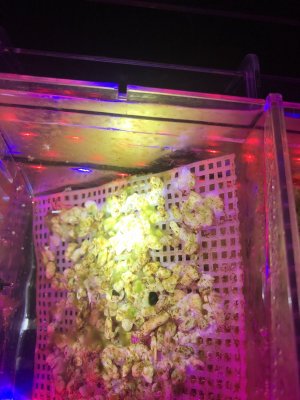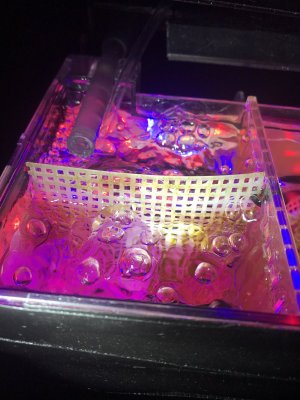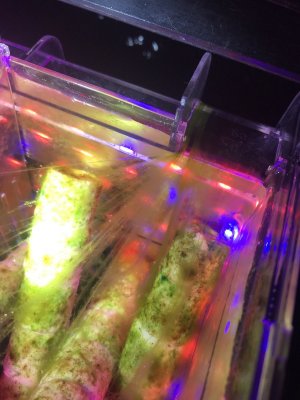"bubble rubbing the surface do have a benefit"
Yes, much increased algal growth and filtration. And it's not gas exchange, it's boundary layer removal. See Adey.
I’m not sure how much I buy into this.. I’ve done both up flows, and reactors as well as reactors with injected air. All three systems produce a vastly differrnt slice algea compared to a waterfall type with actual hair. In all three cases changing both flow of water and air bubbling I’ve still gotten the same dark sheeting algae. If used mesh screens and taken crushed coral smashed it with a hammer into dust glued it to a screen on both sides and still get same dark green sheets. Does it remove nutrients.. yes it does but it’s bit as effective being submerses no matter how you set it up as a waterfall system or even a horizontal setstem. If done this in both salt and freshwater and the results are the same. There is a littl more stringing in salt then fresh but still a dense sheer algae. The best I’ve come up with so far for a submerses system is using pond matrix or fluval bio max as the material vs a screen type material for submersion. Gha just doesn’t attached to screens or modified corser versions like green grabbers which are nothing more then some sand glued to a regular screen for texture. If you go back to the origins of turf scrubbers you’ll see they were invented in the 70’s because of algea growing in rocks in tidal surf areas fully exposed tot water.. (similar to the air water interface of a waterfall system) I’ve had greater results with screens dusted with lotus rock floating at the surface (again better air to water interface) I’ve blasted screens with powerheads, bubbles you name it they never grow the same submersed as a waterfall system and never come close to same reductions. I’ve run 300gph of air over screens, I’ve run 30gph over screens, I’ve run 90gph through a reactor with screens and run 600gph both with and wo bubbles. Increase lighting to 300watt less and reduced to 9watt par 38’s.. I’ve tried every which way of submersible scrubbers you can imagine in past couple years. I’ve gotten better results from using planted fuges or refugiums with cheato (fresh vs salt)
I’m currently waiting on a finnex hob briefer to arrive to try a new submersed method using air, and bio media as well as both vehicle and hirazontal screens covered in crushed corals as a backing. I’ve had much less luck on freshwater tanks with submerged scrubbers over the years and basically trying best I can to copy a marine fuge setup which to date is still more effective then any other freshwater system I’ve seen to include waterfall systems.
I’ll be using an airline with spaces 3/32” holes every 1” lining the bottom perimeter of the hob as well as under the device sections. I will then make a boxed screen setup which makes for perimeter verticals screens as well as replacing the deviders with vertical screens while also lining the bottom in pond matrix on one half and fluval biomax rings on the other while also topping the screen with a horazontal screening at the surface. The idea is to see what grows the most hair algea with same conditions. Basically a 4/1 experiment. I’ll be using 360* lighting of less for flowing.
If I had to guess prior to starting this the bio media will outperform the screens 6x over minimum. I’ve left rinsed media in a bucket outside for 24h and come back to find thick algea growing all over it already with no water movement no nutrients just a stagnant bucket of forgotten tap water.
It’s my experience that in submersed designers the issue isn’t breaking the barrier as much as it is finding the proper surface for attachment.
Box and lights will arrive Monday and I’ll post pictures as I setup and design the system.. it’s my belief in several years of trying everything on multiple systems that fully submerged can be done wo bubbling or blasting flow over an area. The issue has never been beaming the tention at the algea its always been finding the proper foothold where it can thrive. We all have items in the tank growing gha all over and none of these things are getting bubbled or blasted with a powerhead. I’m actually amazed that after 10 is years of tinkering with this you all have not figured this out. Why is it a slick plant leaf can grow algea at will wo bubbles or flow while a textured screen with bubbles grows just slim? How come my sand or level substrate with the least flow and lighting can grow gha? Why is it that in my reef tank gha o my grows in low flow shaded areas of my rock? Always the same.. it’s the foothold. Lighting doesn’t matter, flow doesn’t matter, it’s always been about the substrate it’s attaching to..
I hope when this is over we have smaller cheaper commercialized systems that can be submerged. We will see..
FYI the first system I’ll be putting this is a perfectly healthy planted 55g freshwater tank that doesn’t have nutrient issues. Been testing it every day for past week waiting for product and it’s 10ppm nitrate and undetectable pho’s 24/7. So first test will be the absolute worse case.
Once that is done I’ll move it to a 125g packed full of predictor fish that is already running an upflow and air injected reactor. To see who can out compete who. FYI small reactor and large upflow give identicle results.
After that is complete I’ll put it on one of my saltwater systems. Not sure which yet as they are all ultra low already off regular fuges and really not looking forward to killing my fuge on any of them and upsetting the balance.
Ill post build pictures and updates here as things progress. My plan is to dispose of a lot of the myths and hear say on this topic. I know many of you have spent years testing various setups yet you all dismissed submerged systems right off the bat and that makes no sense as they need the least amount of room and can potentially have the most nutrient availability. And sorry to say the hogs suck.. never used one but I’ve never seen a single review of someone saying they can definitively say it reduced anything in Thier tank. You’ve given away thousands over the years to every YouTubed around and not one has given a review justifying the price tag or eyesore. They all grew algea to some extent yet not a one of them still uses it? Hmmmm
Enjoyed watching you and josh fight over the years tbh.. you know a lot about algae and he knows a lot about tanks. Love seeing turbos views over the years as he always seems to have a sensible approach.. just blows me away with the knowledge on this topic the three of you have that you all have never looked into the basics.. you’ve all been complacent through successful business that none of you have tried to thing logical about how or why algea grows on something but not another thing or why it’s always present in newer tanks with lots of clean rock? Or even why a ul nutrient tank still has gha showing up on rocks? Submerged has always been the answer to all but you’ve all stopped looking at the most nutrient rich atmosphere for algea and fell back on What was easy.. I guess it’s hard to market a $5 hob with $20 lighting and $20 of regular biomedia?
Shame in all of you and I can’t wait to prove it..







